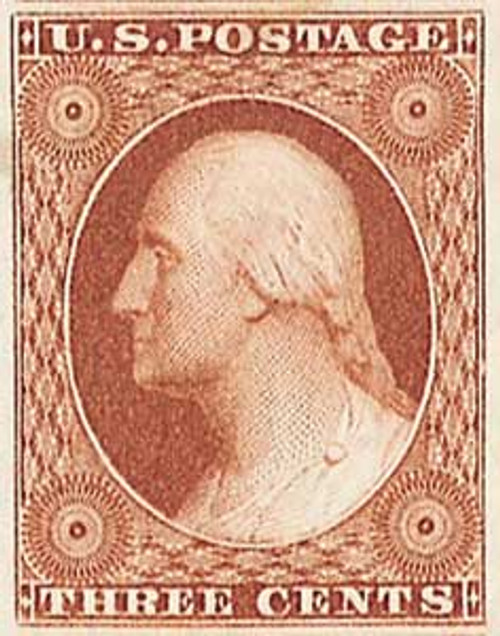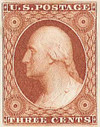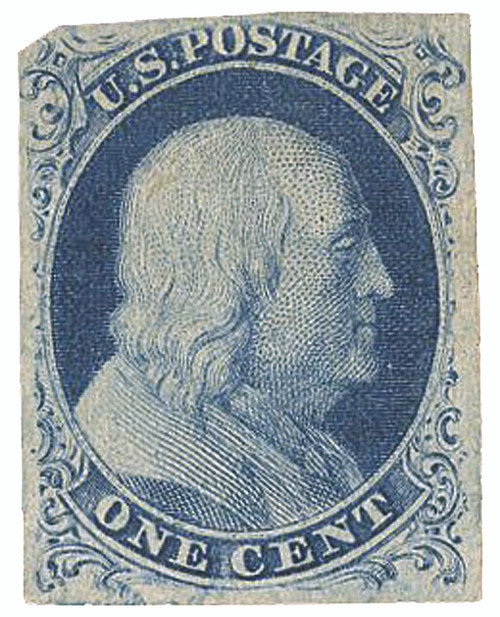
1851-57 3c George Washington, orange-brown, imperforate, type I
# 10 - 1851-57 3c George Washington, orange-brown, imperforate, type I
$165.00 - $4,250.00
U.S. #10
1851 Washington, Type I
- First Three-Cent U.S. postage stamp
Stamp Category: Definitive
Series: 1851-57 Issue
Value: 3c
First Day of Issue: July 1, 1851
Printed by: Toppan, Carpenter, Casilear & Co.
Quantity printed: 362,000,000 (estimate)
Format: Printed in sheets of 200 stamps, divided into two panes of 100 each, in rows of 10x10
Printing Method: Engraving
Perforations: Imperforate
Color: Orange Brown
Why the stamp was issued: The 3c Washington stamp was issued to pay the first-class rate for single letters of one-half ounce or less for a distance of 3,000 miles or less.
About the stamp design: The design is engraved on a die – a small, flat piece of steel. The design is copied to a transfer roll – a blank roll of steel. Several impressions or “reliefs” are made on the roll. The reliefs are transferred to the plate – a large, flat piece of steel from which the stamps are printed.
Types or “varieties” occur when a stamp has differences which vary from the way it was originally engraved. A damaged plate or foreign matter can cause these differences on the plate and on the stamps printed from it. They can also occur when the design is being transferred to the plate when lines are manually re-cut.
Two types of the imperforate 3c stamp were created due to recutting of the plates. The recutting caused differences in the frame lines, among other variations.
Special design details: US #10 is Type I. An outer frame line is found on all four sides. The frame line has been recut on the sides.
George Washington’s portrait on the stamp is based on a statue by French sculptor Jean-Antoine Houdon. The statue is considered by many to be one of the most life-like recreations of America’s first president. It was based on detailed measurements of his body as well as a life mask of his face. Washington’s statue is in the rotunda of the Virginia state capitol building in Richmond.
About the 1851-57 Series: On July 1, 1851, 1c, 3c, and 12c stamps were issued. These new stamps met the reduced postal rates passed by act of Congress on March 3, 1851. U.S. #1 and #2 were demonetized. Later reductions due to the Act of March 3, 1855 led to 10c (1855) and 5c (1856) additions to the series. Perforated stamps of the same designs (plus three new designs) would be issued in 1857.
History the stamp represents:
America’s first two postage stamps were issued in 1847. Rates were determined by the weight and distance the letter was mailed. Letters mailed 300 miles or less were 5¢ per half ounce; while those mailed over 300 miles were 10¢ per half ounce. Postage could be paid by the sender at the time the letter was mailed, or by the addressee upon receipt.
These stamps and rates remained in use until 1851, when the Congress reduced postal rates. These new rates created the need for new denominations. The first stamps issued to meet the lower rates were issued on July 1, 1851. The new 1¢ stamp was used on newspapers, circulars, and “drop letters” (letters mailed to the same town.) The single letter rate, based on a half-ounce, was changed to 3¢ for mail sent up to and including 3,000 miles. Mail exceeding this distance was lowered to 6¢ and two of the new 3c stamps could be used to pay postage to the West Coast. Besides the 1c and 3c stamps, a 12c stamp was issued.
Prepayment was still optional. If postage was paid by the addressee upon receipt, the rate was higher. Due to increased collect rates, the use of postage stamps was greatly stimulated. The cheaper rates were attractive to Americans, too. Prepayment of postage with stamps was made mandatory January 1st, 1856.
U.S. #10
1851 Washington, Type I
- First Three-Cent U.S. postage stamp
Stamp Category: Definitive
Series: 1851-57 Issue
Value: 3c
First Day of Issue: July 1, 1851
Printed by: Toppan, Carpenter, Casilear & Co.
Quantity printed: 362,000,000 (estimate)
Format: Printed in sheets of 200 stamps, divided into two panes of 100 each, in rows of 10x10
Printing Method: Engraving
Perforations: Imperforate
Color: Orange Brown
Why the stamp was issued: The 3c Washington stamp was issued to pay the first-class rate for single letters of one-half ounce or less for a distance of 3,000 miles or less.
About the stamp design: The design is engraved on a die – a small, flat piece of steel. The design is copied to a transfer roll – a blank roll of steel. Several impressions or “reliefs” are made on the roll. The reliefs are transferred to the plate – a large, flat piece of steel from which the stamps are printed.
Types or “varieties” occur when a stamp has differences which vary from the way it was originally engraved. A damaged plate or foreign matter can cause these differences on the plate and on the stamps printed from it. They can also occur when the design is being transferred to the plate when lines are manually re-cut.
Two types of the imperforate 3c stamp were created due to recutting of the plates. The recutting caused differences in the frame lines, among other variations.
Special design details: US #10 is Type I. An outer frame line is found on all four sides. The frame line has been recut on the sides.
George Washington’s portrait on the stamp is based on a statue by French sculptor Jean-Antoine Houdon. The statue is considered by many to be one of the most life-like recreations of America’s first president. It was based on detailed measurements of his body as well as a life mask of his face. Washington’s statue is in the rotunda of the Virginia state capitol building in Richmond.
About the 1851-57 Series: On July 1, 1851, 1c, 3c, and 12c stamps were issued. These new stamps met the reduced postal rates passed by act of Congress on March 3, 1851. U.S. #1 and #2 were demonetized. Later reductions due to the Act of March 3, 1855 led to 10c (1855) and 5c (1856) additions to the series. Perforated stamps of the same designs (plus three new designs) would be issued in 1857.
History the stamp represents:
America’s first two postage stamps were issued in 1847. Rates were determined by the weight and distance the letter was mailed. Letters mailed 300 miles or less were 5¢ per half ounce; while those mailed over 300 miles were 10¢ per half ounce. Postage could be paid by the sender at the time the letter was mailed, or by the addressee upon receipt.
These stamps and rates remained in use until 1851, when the Congress reduced postal rates. These new rates created the need for new denominations. The first stamps issued to meet the lower rates were issued on July 1, 1851. The new 1¢ stamp was used on newspapers, circulars, and “drop letters” (letters mailed to the same town.) The single letter rate, based on a half-ounce, was changed to 3¢ for mail sent up to and including 3,000 miles. Mail exceeding this distance was lowered to 6¢ and two of the new 3c stamps could be used to pay postage to the West Coast. Besides the 1c and 3c stamps, a 12c stamp was issued.
Prepayment was still optional. If postage was paid by the addressee upon receipt, the rate was higher. Due to increased collect rates, the use of postage stamps was greatly stimulated. The cheaper rates were attractive to Americans, too. Prepayment of postage with stamps was made mandatory January 1st, 1856.


















